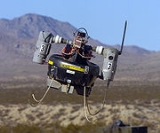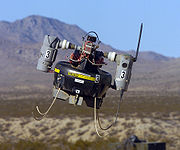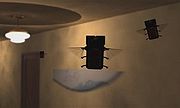
Micro air vehicle
Encyclopedia


Unmanned aerial vehicle
An unmanned aerial vehicle , also known as a unmanned aircraft system , remotely piloted aircraft or unmanned aircraft, is a machine which functions either by the remote control of a navigator or pilot or autonomously, that is, as a self-directing entity...
s (UAV) that has a size restriction and may be autonomous. Modern craft can be as small as 15 centimetres. Development is driven by commercial, research, government, and military purposes; with insect
Insect
Insects are a class of living creatures within the arthropods that have a chitinous exoskeleton, a three-part body , three pairs of jointed legs, compound eyes, and two antennae...
-sized aircraft reportedly expected in the future. The small craft allows remote observation of hazardous environments inaccessible to ground vehicles. MAVs have been built for hobby purposes, such as aerial robotics contests and aerial photography.
Configurations
Micro air vehicles are either fixed-wing aircraftFixed-wing aircraft
A fixed-wing aircraft is an aircraft capable of flight using wings that generate lift due to the vehicle's forward airspeed. Fixed-wing aircraft are distinct from rotary-wing aircraft in which wings rotate about a fixed mast and ornithopters in which lift is generated by flapping wings.A powered...
, rotary-wing aircraft (helicopter
Helicopter
A helicopter is a type of rotorcraft in which lift and thrust are supplied by one or more engine-driven rotors. This allows the helicopter to take off and land vertically, to hover, and to fly forwards, backwards, and laterally...
), or flapping-wing (of which the ornithopter
Ornithopter
An ornithopter is an aircraft that flies by flapping its wings. Designers seek to imitate the flapping-wing flight of birds, bats, and insects. Though machines may differ in form, they are usually built on the same scale as these flying creatures. Manned ornithopters have also been built, and some...
is a subset) designs; with each being used for different purposes. Fixed-wing craft require higher, forward flight speeds to stay airborne, and are therefore able to cover longer distances; however they are unable to effectively maneuver inside structures such as buildings. Rotary-wing designs allow the craft to hover and move in any direction, at the cost of requiring closer proximity for launch and recovery. Flapping-wing-powered flight has yet to reach the same level of maturity as fixed-wing and rotary-wing designs. However, flapping-wing designs, if fully realized, would boast a maneuverability that is superior to both fixed- and rotary-wing designs due to the extremely high wing loadings achieved via unsteady aerodynamics.
Aerodynamics/aeroelastic aspect
The range of Reynolds numbers at which MAVs fly is similar to that of an insect or bird (103 - 105). Thus, some researchers think that understanding bird flightBird flight
Flight is the main mode of locomotion used by most of the world's bird species. Flight assists birds while feeding, breeding and avoiding predators....
or insect flight
Insect flight
Insects are the only group of invertebrates known to have evolved flight. Insects possess some remarkable flight characteristics and abilities, still far superior to attempts by humans to replicate their capabilities. Even our understanding of the aerodynamics of flexible, flapping wings and how...
will be useful to designing MAVs. The flapping motion used by birds and insects to produce lift involves aeroelasticity
Aeroelasticity
Aeroelasticity is the science which studies the interactions among inertial, elastic, and aerodynamic forces. It was defined by Arthur Collar in 1947 as "the study of the mutual interaction that takes place within the triangle of the inertial, elastic, and aerodynamic forces acting on structural...
, which introduces structural considerations. Unsteady aerodynamics are also present in this type of motion.
Bio-inspiration
A new trend in the MAV community is to take inspiration from flying insects or birds to achieve unprecedented flight capabilities. Biological systems are not only interesting to MAV engineers for their use of unsteady aerodynamics with flapping wings; they are increasingly inspiring engineers for other aspects such as distributed sensing and acting, sensor fusion and information processing. Symposiums bringing together biologists and aerial roboticists have been held in 2007 and some books have recently been published on this topic.Practical implementations
In January 2010, the Tamkang UniversityTamkang University
Tamkang University is a private Taiwanese university located in Tamsui District, New Taipei City. Founded in 1950 as a junior college of English literature, the college has expanded into a full university with 11 colleges today....
(TKU) in Taiwan
Taiwan
Taiwan , also known, especially in the past, as Formosa , is the largest island of the same-named island group of East Asia in the western Pacific Ocean and located off the southeastern coast of mainland China. The island forms over 99% of the current territory of the Republic of China following...
realized autonomous control of the flight altitude of an 8-gram, 20-centimeter wide, flapping-wing MAV. (See http://www.multiupload.com/GPAG93UIJI for video download.) The MEMS Lab in the TKU has been developing MAVs for several years, and since 2007 the Space and Flight Dynamics (SFD) Lab has joined the research team for the development of autonomous flight of MAVs. Instead of traditional sensors and computational devices, which are too heavy for most MAVs, the SFD combined a stereo-vision system with a ground station to control the flight altitude, making it the first flapping-wing MAV under 10 grams that realized autonomous flight.
In 2008, the TU Delft University in the Netherlands
Netherlands
The Netherlands is a constituent country of the Kingdom of the Netherlands, located mainly in North-West Europe and with several islands in the Caribbean. Mainland Netherlands borders the North Sea to the north and west, Belgium to the south, and Germany to the east, and shares maritime borders...
developed the smallest ornithopter fitted with a camera, the Delfly Micro, the third version of the Delfly project that started in 2005 (see Delfly.nl for photographs). This version measures 10 centimeters and weighs 3 grams, slightly larger (and noisier) than the dragonfly
Dragonfly
A dragonfly is a winged insect belonging to the order Odonata, the suborder Epiprocta or, in the strict sense, the infraorder Anisoptera . It is characterized by large multifaceted eyes, two pairs of strong transparent wings, and an elongated body...
on which it was modeled. The importance of the camera lies in remote control when the Delfly is out of sight. However, this version has not yet been successfully tested outside, although it performs well indoors. Researcher David Lentink of Wageningen University
Wageningen University
Wageningen University and Research Centre is a Dutch public university in Wageningen, The Netherlands. It consists of Wageningen University, the Van Hall-Larenstein School of Higher Professional Education, and the former agricultural research institutes of the Dutch Ministry of Agriculture...
, who participated in the development of previous models, DelFly I and DelFly II, says it will take at least half a century to mimic the capabilities of insects, with their low energy consumption and multitude of sensors—not only eyes, but gyroscope
Gyroscope
A gyroscope is a device for measuring or maintaining orientation, based on the principles of angular momentum. In essence, a mechanical gyroscope is a spinning wheel or disk whose axle is free to take any orientation...
s, wind sensors, and much more. He says fly-size ornithopters should be possible, provided the tail is well designed. Rick Ruijsink of TU Delft cites battery weight as the biggest problem; the lithium-ion battery in the Delfly micro, at one gram, constitutes a third of the weight. Luckily, developments in this area are still going very fast, due to demand in various other commercial fields.
The next goals are an ornithopter weighing just one gram with a size of 3 centimeters, and a helicopter with the same specifications. There are no biological examples of such a design, but Lentink is looking into the flight of hummingbirds.
Ruijsink says the purpose of these craft is to understand insect flight and to provide practical uses, such as flying through cracks in concrete to search for earthquake victims or exploring a radioactivity-contaminated buildings. Spy agencies and the military also see potential for such small vehicles as spies and scouts.
Robert Wood at Harvard University
Harvard University
Harvard University is a private Ivy League university located in Cambridge, Massachusetts, United States, established in 1636 by the Massachusetts legislature. Harvard is the oldest institution of higher learning in the United States and the first corporation chartered in the country...
developed an even smaller ornithopter, at just 3 centimeters, but this craft is not autonomous in that it gets its power through a wire and is led along a rail.
In early 2008 the United States
United States
The United States of America is a federal constitutional republic comprising fifty states and a federal district...
company Honeywell
Honeywell
Honeywell International, Inc. is a major conglomerate company that produces a variety of consumer products, engineering services, and aerospace systems for a wide variety of customers, from private consumers to major corporations and governments....
received FAA
Federal Aviation Administration
The Federal Aviation Administration is the national aviation authority of the United States. An agency of the United States Department of Transportation, it has authority to regulate and oversee all aspects of civil aviation in the U.S...
approval to operate its MAV, designated as gMAV in the national airspace on an experimental basis. The gMAV is the fourth MAV to receive such approval. The Honeywell gMAV uses ducted thrust
Thrust
Thrust is a reaction force described quantitatively by Newton's second and third laws. When a system expels or accelerates mass in one direction the accelerated mass will cause a force of equal magnitude but opposite direction on that system....
for lift, allowing it to takeoff and land vertically and to hover. It is also capable of "high-speed" forward flight, according to the company, but no performance figures have been released. The company also states that the machine is light enough to be carried by a man. It was originally developed as part of a DARPA program, and its initial application is expected to be with the police department of Miami-Dade County, Florida
Miami-Dade County, Florida
Miami-Dade County is a county located in the southeastern part of the state of Florida. As of 2010 U.S. Census, the county had a population of 2,496,435, making it the most populous county in Florida and the eighth-most populous county in the United States...
.
Flapping Wing MAV
Wright State University (WSU) in Dayton, Ohio is home of the Center for Micro Air Vehicle Studies (CMAVS) , an Ohio Center of Excellence. WSU has developed multiple Flapping Wing Micro Air Vehicles (FWMAV). The most stable platforms are 4-wing clap-and-fling models similar to those produced by DELFLY. These models are controllable enough to land and take-off from a person's hand while carrying a 1.5g color camera. Videos can be found on YouTube.com search WSU MAV.In addition to the stable 4-wing platforms they are also producing 2-wing, tailless, models which more closely mimic the flight characteristics of a hummingbird.
Practical Limitations
Although there are currently no true MAVs (i.e., truly micro scaled flyers) in existence, DARPA has attempted a program to develop even smaller Nano Air Vehicles (NAVs) with a wingspan of 7.5 centimeters. However, no NAVs meeting DARPA's original program specification were forthcoming until 2009. AeroVironment has recently demonstrated a controlled hovering of DARPA's flapping-wing NAV.Beyond the difficulties in developing MAVs, few designs adequately address control issues. The MAVs' small size makes teleoperation impractical because a ground station pilot cannot see it beyond 100 meters. An onboard camera allowing the ground pilot to stabilize and navigate the craft was first demonstrated in the Aerovironment Black Widow, but truly micro air vehicles cannot carry onboard transmitters powerful enough to allow for teleoperation. For this reason, some researchers have focused on fully autonomous MAV flight. One such device, which has been designed from its inception as a fully autonomous MAV, is the Entomopter
Entomopter
The Entomopter is a multimode insect-like robot developed by Prof. Robert C. Michelson and his design team from the Georgia Tech Research Institute , University of Cambridge , ETS Labs and others. The name 'Entomopter' is derived from entomo + pteron...
originally developed at the Georgia Institute of Technology under a DARPA contract by Robert C. Michelson
Robert C. Michelson
Robert C. Michelson is an American engineer and academic widely known for inventing the entomopter, a biologically inspired flapping-winged aerial robot, and for having established the International Aerial Robotics Competition. He has received degrees in electrical engineering from the Virginia...
.
Given that MAVs can be controlled by autonomous means, significant test and evaluation issues continue to exist.
See also
- Aerial reconnaissanceAerial reconnaissanceAerial reconnaissance is reconnaissance that is conducted using unmanned aerial vehicles or reconnaissance aircraft. Their roles are to collect imagery intelligence, signals intelligence and measurement and signature intelligence...
- EntomopterEntomopterThe Entomopter is a multimode insect-like robot developed by Prof. Robert C. Michelson and his design team from the Georgia Tech Research Institute , University of Cambridge , ETS Labs and others. The name 'Entomopter' is derived from entomo + pteron...
- History of unmanned aerial vehiclesHistory of unmanned aerial vehiclesUnmanned aerial vehicles, known variously as UAVs, drones, and remotely piloted vehicles , have been a feature of aviation for much of its history, though often overlooked. For the purposes of this article, and to distinguish UAVs from missiles, a UAV is defined as being capable of controlled,...
- Hybrid Insect Micro-Electro-Mechanical SystemsHybrid Insect Micro-Electro-Mechanical SystemsHybrid Insect Micro-Electro-Mechanical Systems is a project of DARPA, a unit of the United States Department of Defense, with the goal of developing tightly coupled machine-insect interfaces by placing micro-mechanical systems inside the insects during the early stages of metamorphosis...
- Miniature helicopterMiniature helicopterMiniature helicopters are remotely controlled helicopters with a weight ranging from hundred grams to a few grams. Most in production are toys aimed at hobbyists and enthusiasts. In addition there are many companies making prototypes for military and security applications...
- Miniature UAVs
- Model aircraftModel aircraftModel aircraft are flying or non-flying models of existing or imaginary aircraft using a variety of materials including plastic, diecast metal, polystyrene, balsa wood, foam and fibreglass...
- SurveillanceSurveillanceSurveillance is the monitoring of the behavior, activities, or other changing information, usually of people. It is sometimes done in a surreptitious manner...
- Unmanned aerial vehicleUnmanned aerial vehicleAn unmanned aerial vehicle , also known as a unmanned aircraft system , remotely piloted aircraft or unmanned aircraft, is a machine which functions either by the remote control of a navigator or pilot or autonomously, that is, as a self-directing entity...
(UAV)
Further reading
- Peter Forbes, The Gecko's Foot: How Scientists are Taking a Leaf from Nature's Book, Harper Perennial, 2006, pp. 161–179.

